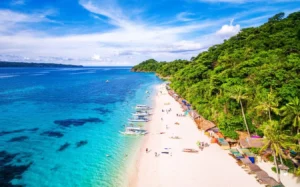An Introduction to Batanes
Batanes, the northernmost province of the Philippines, is an archipelago composed of ten volcanic islands. It is situated in the Philippines Sea and is often referred to as the “home of the Ivatans.” This region boasts a unique geographical location, which contributes to its breathtaking landscapes characterized by rolling hills, rugged coastlines, and lush green valleys. The natural beauty of Batanes is complemented by its serene atmosphere and picturesque scenery, making it an alluring destination for travelers seeking peace away from the hustle and bustle of urban life.
The cultural heritage of Batanes is a fascinating blend of Spanish colonial influence and indigenous Ivatan traditions. The Ivatan people, known for their resilience and hospitality, maintain a way of life that reflects their rich history. Their traditional houses, built from limestone and thatched roofs, are designed to withstand the region’s harsh weather, showcasing their ingenuity and adaptability. In Batanes, the enduring traditions and customs of the Ivatan community are visibly ingrained in daily life, from local culinary practices to unique festivals that celebrate their heritage.
Batanes not only captivates visitors with its stunning landscapes but also offers historical significance. The islands are dotted with ancient stone markers, known as “batiw,” which serve as reminders of the Ivatan’s ancestors and their connection to the land. Local folklore, combined with the preserved structures from the Spanish era, provides an intriguing glimpse into the region’s past. Considered a hidden gem within the Philippines, Batanes remains a relatively untouched paradise, appealing to those in search of tranquility and natural beauty. With its unique cultural attributes and picturesque environments, Batanes is undeniably a must-visit destination for those traversing the Philippines.
Stunning Landscapes and Natural Wonders
Batanes, an archipelago in the northernmost part of the Philippines, is renowned for its stunning landscapes and natural wonders. The rolling hills that dominate the terrain offer breathtaking panoramic views, where the lush green valleys meet the dramatic cliffs that plunge into the azure sea. This juxtaposition of land and water creates a picturesque setting that captivates both visitors and locals alike.
One of the most iconic sites in Batanes is Nakabuang Beach, located on the island of Sabtang. This mesmerizing beach features powdery white sands framed by unique rock formations, offering a tranquil escape for sunbathers and nature enthusiasts. The clear turquoise waters provide an inviting environment for swimming, while the surrounding cliffs offer opportunities for exploration and photography. Another remarkable site is Marlboro Country, where one can witness vast stretches of rolling hills that seem to stretch endlessly. The stunning landscape is particularly enchanting during sunrise and sunset, as the changing light transforms the scenery into a living canvas of colors.
The unique geography of Batanes not only contributes to its remarkable aesthetic appeal but also influences the climate and ecology of the region. The islands experience a temperate climate, shaped by the surrounding sea and the winds that sweep across the landscape. This climate supports a variety of flora and fauna, many of which are endemic to the region. The rich biodiversity enhances the natural beauty of Batanes, making it a haven for nature lovers and wildlife enthusiasts. Birdwatching opportunities abound, as numerous species nest in the cliffs and valleys. In conclusion, the stunning landscapes and natural wonders of Batanes are a testament to the island’s enchanting environment, inviting visitors to experience its breathtaking beauty firsthand.
Cultural Heritage and Local Traditions
Batanes, the northernmost province of the Philippines, is renowned not only for its breathtaking landscapes but also for its rich cultural heritage, primarily rooted in the traditions of the Ivatan people. The Ivatan are known for their resilience and unique way of life that has been shaped by the region’s challenging environment. One of the most iconic aspects of Ivatan culture is their traditional stone houses, referred to as ‘Batanes houses.’ These structures, characterized by their sturdiness and distinct architectural style, are designed to withstand the strong winds and heavy rains typical of the region. The use of locally sourced limestone and coral stones demonstrates the Ivatan’s profound connection to their natural surroundings, as well as their impressive craftsmanship.
Another significant aspect of Batanes’ cultural fabric is its local craftsmanship, particularly in weaving. Batanes is known for producing traditional textiles using natural fibers that reflect the community’s artistry and ingenuity. The ivatan weavers employ intricate techniques passed down through generations, creating unique patterns and colors that encapsulate local identity. Visitors to Batanes often have the opportunity to witness these weavers at work, providing an insightful glimpse into their enduring cultural legacy.
In addition to their craftsmanship, the Ivatan people take great pride in their cuisine, which showcases the abundant local ingredients. Ivatan dishes often feature fresh seafood, root crops, and locally sourced vegetables, with specialties such as ‘ubod’ (heart of palm) and ‘lattuk’ (a type of leafy green). Meal times are often communal, reinforcing the close-knit nature of the community. Furthermore, the Ivatan celebrate various festivals that honor their heritage, including the ‘Nawman Festival’ which showcases traditional music, dances, and local crafts. Such events illuminate the Ivatan’s deep respect for nature and their commitment to preserving their cultural identity, making a visit to Batanes a truly immersive experience.
Travel Tips for Visiting Batanes
Visiting Batanes promises a unique experience filled with stunning landscapes and rich cultural heritage. To fully enjoy your journey, it is essential to consider a few travel tips that enhance your trip and encourage responsible tourism. The best time to visit Batanes is during the dry season, which extends from December to May. During these months, travelers can expect clearer skies and milder weather, creating ideal conditions for exploration.
Reaching Batanes can be accomplished via direct flights from Manila to Basco, the capital town of the province. These flights are infrequent, so it is advisable to book well in advance. Once in Batanes, engaging local transportation options, such as tricycles or hired vehicles, will greatly facilitate your travel between the various islands and attractions. Consider utilizing local guides, as they possess valuable insights and can provide a more enriching experience while supporting the local economy.
When planning accommodations, it is wise to explore options that align with your preferences. Various guesthouses, inns, and lodges are available, often run by locals who can offer personalized experiences. Make sure to check reviews and availability before your arrival, especially during peak tourist seasons.
Being a responsible traveler in this pristine environment is paramount. Visitors should respect local customs and traditions, minimizing their impact on the cultural integrity of the region. To preserve the natural beauty of Batanes, always practice eco-friendly habits, such as avoiding littering, using refillable water bottles, and following established trails and guidelines set by local organizers. By doing so, travelers can contribute to the sustainable development of this breathtaking destination, ensuring that its beauty remains intact for future generations.







